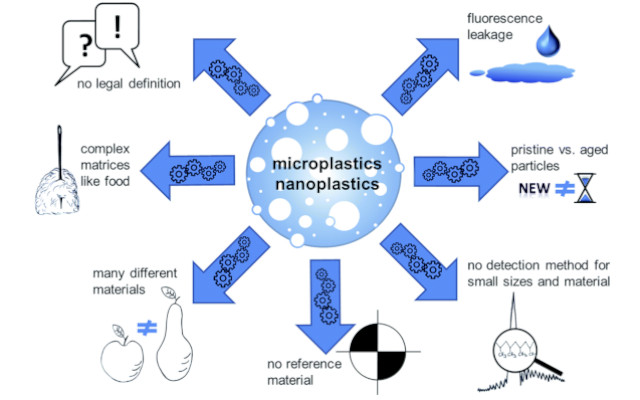The European Commission has adopted the first restrictions on certain uses of microplastics, in a mini-reform of REACH (Registration, Evaluation, Authorisation and restriction of Chemicals) Regulation (EC) No 1907/2006. (1)
The measures concern synthetic polymer microparticles deliberately included in some products to fulfill various functions. With broad exemptions and progressivity justified by the need to ‘limit disturbances’ in the poison market.
Fertilizers, pesticides and other substances for use in agriculture-as well as food additives-are partly covered by the new rules, amid various exemptions and long transitional periods.
1) Microplastics, environmental disaster and public health risks
Microplastic pollution is one of the most severely underreported environmental and public health disasters. (2) These microparticles, as seen:
– are ubiquitous in fresh and salt waters, agricultural soils, and the atmosphere,

– reach humans through air, drinking water and food (e.g., aquatic organisms, fruits and vegetables and other foods),
– until it reaches and is deposited in human tissues (e.g., placenta, blood, lungs).
2) Microplastics, classification and sources.
JRC – Joint Research Center, European Commission – includes among microplastics all solid particles (between 0.1 and 5,000 μm, in general) composed of mixtures of polymers and functional additives, often also characterized by the presence of impurities.
Microplastics are deliberately added to various categories of products (e.g., pesticides and fertilizers, food contact materials and objects, cosmetics) to fulfill specific functions, as well as resulting from the wear and tear of objects of different sizes (e.g., textiles, tires). (3,4)
3) European Union, mild initiatives for plastic reduction.
The European Council has repeatedly urged the Commission to propose measures to reduce the dispersion of plastic residues of all forms (macro and micro) into the marine environment, including by banning the use of polymers in specific products such as cosmetics, personal care products and detergents. (5) From words to deeds:
– The European Commission adopted the ‘European Strategy for Plastics in the Circular Economy,’ under which the Single Use Plastics Directive was developed. With some critical issues, including in transposition in member states (e.g. Italy),
– the European Court of Auditors, in its report ‘EU Action to tackle the plastic waste problem’ (2020), analyzed the ineffectiveness of the measures taken against the targets set. Also with regard to the problem of microplastic pollution.
4) First restrictions on the use of microplastics in the REACH mini-reform. Excursus
ECHA (European Chemicals Agency) has published a dossier-at the request of the Commission under REACH, Annex XV-which includes:
- Analysis of environmental risks associated with the intentional use of microplastics,
- risk management proposal, which includes a ban on the use of microplastics in certain areas from which their inevitable release into the environment results,
- impact assessment of the proposed measures, as a result of which it is estimated that there will be a reduction in the emission of 500,000 tons of plastic into the environment in the twenty years following the introduction of the aforementioned ban.
ECHA’s dossier considered the sizes and groups of polymers of greatest interest, excluding those that are biodegradable or water-soluble as well as natural polymers that are not chemically modified, and proposed standard test methods and thresholds for assessing biotic degradability or solubility. Also proposing the duration of transitional periods, where deemed necessary, in the introduction of the ban on the use of plastic polymers on various categories of products.
RAC and SEAC – ‘Committee for Risk Assessment’ and ‘Committee for Socio-economic Analysis,’ in ECHA – have since adopted opinions that agree in part with the initial dossier, proposing a number of changes. (6) The European Commission then adopted the mini-reform under consideration of the REACH Regulation on September 25, 2023, through Regulation (EU) 2023/2055. (7)
5) Restrictions on the deliberate use of microplastics in certain products, new EU rules
The restrictions introduced in the mini-reform of the REACH regulation concern ‘synthetic polymer microparticles,’ defined as ‘solid polymers that meet both of the following conditions:
(a) are contained in particles and constitute at least 1 percent, by weight, of those particles, or create a continuous surface coating on the particles,
(b) at least 1 percent by weight of the particles referred to in par. (a) It meets one of the following conditions:
(i) all particle sizes are 5 mm or less,
(ii) the length of the particles is 15 mm or less and their length-to-diameter ratio is more than 3’.
Excluded from this definition, however, are:
‘(a) polymers derived from polymerization processes that took place in nature, regardless of the extraction process, which are not chemically modified substances,
(b) degradable polymers as demonstrated in accordance with Appendix 15,
(c) polymers having a solubility greater than 2 g/l, as demonstrated in accordance with Appendix 16,
(d) polymers that do not contain carbon atoms in their chemical structure‘.
5.1) Exceptions
REACH Regulation already excludes from its scope products already subject to industry regulations, with respect to both individual substances and their mixtures in their finished state, intended for the end user. (8) They are therefore at least partly excluded from the scope of the mini-reform, subject to information duties (see supra, paragraphs 5.2,5.3):
- Medicines and veterinary medicines,
- EU fertilizer products,
- foods and food additives,
- In vitro diagnostic medical devices.
Microparticles of synthetic polymers intended for use at industrial sites are also excluded, as well as:
(a) synthetic polymer microparticles contained by technical means so as to avoid releases to the environment when used in accordance with the instructions for use during the intended end use,
(b) microparticles of synthetic polymers whose physical properties are permanently changed during the intended end use so that the polymer no longer falls within the scope of this heading,
(c) synthetic polymer microparticles permanently embedded in a solid matrix during the intended end use.
5.2) Prohibitions
Microparticles of synthetic polymers cannot be marketed as such or be used in products to give them the characteristics sought if they are present at a concentration of 0.01 percent by weight or more. In cases where it is impossible to determine the concentration of microparticles through analytical methods or accompanying documents, only those of the following sizes are considered:
- 0.1 μm on any side, for particles having all sizes at most 5 mm,
- 0.3 μm in length, for particles having a maximum length of 15 mm and a length-to-diameter ratio greater than 3.
5.3) Duties of information to users and consumers
Specific information duties to users and consumers can be fulfilled with text messages, in some cases also with pictograms – in relation to different types
of product-on labels, MSDSs, package inserts. And there is provision for, among other things, the possibility of using digital tools to provide (without special emphasis) the information electronically.
Suppliers of synthetic polymer microparticles for industrial uses, as of October 17, 2025, must provide the following information:
(a) instructions for use and disposal that explain to downstream industrial users how to prevent the release of synthetic polymer microparticles into the environment,
(b) the statement ‘The supplied synthetic polymer microparticles are subject to the conditions set out in Annex XVII, item 78. 1907/2006 of the European Parliament and of the Council‘,
(c) information on the amount or, if applicable, the concentration of synthetic polymer microparticles in the substance or mixture,
(d) generic information on the identity of the polymers contained in the substance or mixture, to enable manufacturers, industrial downstream users and other suppliers to fulfill their obligations on the submission of information to ECHA (see Section 5.3 below).
Labels of food additives and in in vitro diagnostic medical devices–as of 17.10.26 and 17.10.27, respectively–must include instructions for use and disposal to explain to professional users and the public how to prevent releases of synthetic polymer microparticles.
5.4) Annual reports to be submitted to ECHA.
Manufacturers and users downstream must submit a set of information to ECHA by May 31 of each year-starting in 2026 (in cases of synthetic polymer microparticles in pellet, flake and powder form only, used as raw materials in the manufacture of plastics at industrial sites) and 2027 (in other cases):
(a) description of the uses of synthetic polymer microparticles in the previous calendar year,
(b) generic information on the identity of polymers used for each use of synthetic polymer microparticles,
(c) for each use of synthetic polymer microparticles, an estimate of the amount of synthetic polymer microparticles released into the environment in the previous calendar year, including the amount of synthetic polymer microparticles released into the environment during transportation,
(d) for each use of synthetic polymer microparticles, a reference to the exemption for use at industrial sites. (9)
The identity and function of the polymers contained in the products must be provided to competent authorities upon request. If the information is not available, it must be requested from the suppliers or, if the latter does not intend to report it to the operator, it must act as a direct liaison with the competent authorities.
Operators who make and use microparticles of synthetic polymers excluded from the new rules on the grounds of degradability or solubility must provide information to support the demonstration that the polymers are indeed degradable or soluble, based on the new modalities defined in Appendix 15 and Appendix 16, respectively.
5.5) Transient periods
The new rules do not apply to microparticles placed on the market before October 17, 2023. Long transitional periods are defined for different sectors and products, ‘so as toencourage and facilitate technological and market innovations, enabling the identification of market and environmentally sound alternatives.’ The application of the mini-reform is therefore postponed, depending on the uses of microparticles, by:
– Four years (17.10.2027) for cosmetic products to be ‘rinsed out’,
– five years (17.10.28) for detergents, waxes, polishes and air scenting products, as well as for general fertilizer products (other than EU fertilizer products) and other products intended for use in agriculture and/or horticulture,
– six years (17.10.29) for fragrance encapsulation, ‘do not rinse’ cosmetic products, medical devices,
– eight years (17.10.31) for plant protection products (i.e. pesticides, herbicides, etc.) and seeds tanned with such products, biocides; granular infill for use on synthetic sports surfaces,
– twelve years (17.10.35) for lip, nail and makeup products. These products can report ‘This product contains microplastics‘ on the label, which is mandatory as of October 17, 2031. With the exception of products containing ‘microbeads’ (synthetic polymer microparticles to be used as abrasives, i.e., for exfoliating, polishing or cleaning), which are not subject to any transition period.
6) Interim Conclusions
The mini-reform of the REACH regulation-though bland, full of exemptions and untimely in its timing-is the first restriction on the intentional use of synthetic polymer microparticles in a range of products. In line with some incipits of ‘Green Deal’, ‘Circular Economy Action Plan’, ‘Zero Pollution Action Plan’. Not enough for a significant reduction in microplastic pollution.
The ‘Restrictions Roadmap under the Chemicals Strategy for Sustainability’ published by the European Commission in 2022, moreover, had envisioned the gradual banning of thousands of other toxic chemicals-including PVC, PFAS, flame retardants, parabens-to be completed by 2030. But the Commission led by Ursula von der Leyen has prioritized the private interests of Corporations over the proclaimed need to protect public health.
Dario Dongo and Andrea Adelmo Della Penna
Cover image: Challenges and pitfalls in the field of micro- and nanoplastics research (Paul et al., 2020. Citation in Figure 1)
Notes
(1) Commission Regulation (EU) 2023/2055 of September 25, 2023, amending Annex XVII of Regulation (EC) No. 1907/2006 concerning the Registration, Evaluation, Authorization and Restriction of Chemicals (REACH) with regard to synthetic polymer microparticles. http://data.europa.eu/eli/reg/2023/2055/oj
(2) Paola Palestini, Dario Dongo. Microplastics and human health, the invisible evil. GIFT (Great Italian Food Trade). 18.3.19
(3) Munoz-Pineiro M. (2018). MICROPLASTICS: Focus on Food and Health. Publications Office of the European Union JRC110629, https://publications.jrc.ec.europa.eu/repository/handle/JRC110629
(4) Researchers divide microplastics into:
- primary, that is, released directly into the environment in the form of small particles (15-31% of microplastics in the seas), and
- secondary, resulting from the degradation of larger objects (e.g., plastic bags, bottles, fishing nets. 68-81% of microplastics in the seas)
(5) See Council conclusions on ‘The Missing Link – European Union Action Plan for the Circular Economy’ and ‘International Ocean Governance: an agenda for the future of our oceans’
(6) The dossier prepared by ECHA (under REACH Regulation, Annex XV) and the opinions of the committees are available at https://echa.europa.eu/it/registry-of-restriction-intentions/-/dislist/details/0b0236e18244cd73
(7) The restrictions are adopted pursuant to Reg. 1907/2006, Art. 68(1)
(8) See reg. (EC) no. 1907/2006, Art. 2(5) and (6)
(9) Similar conditions apply to suppliers of medicinal and veterinary drugs, food additives, and in vitro diagnostic medical devices containing synthetic polymer microparticles, placed on the market for the first time for professional users and the public:
(a) A description of the end uses for which synthetic polymer microparticles were placed on the market in the previous calendar year,
(b) for each end use for which synthetic polymer microparticles were placed on the market, generic information on the identity of the polymers placed on the market in the previous calendar year,
(c) for each end use for which the synthetic polymer microparticles were placed on the market, an estimate of the amount of synthetic polymer microparticles released into the environment in the previous calendar year, including the amount of synthetic polymer microparticles released into the environment during transportation,
(d) for each use of synthetic polymer microparticles, a reference to the exemption(s) applicable to the specific products, or the forms excluded from the scope
(10) Alessandra Mei. Postponed approval of changes to REACH. The chemical lobby can rejoice. GIFT (Great Italian Food Trade). 26.10.22








